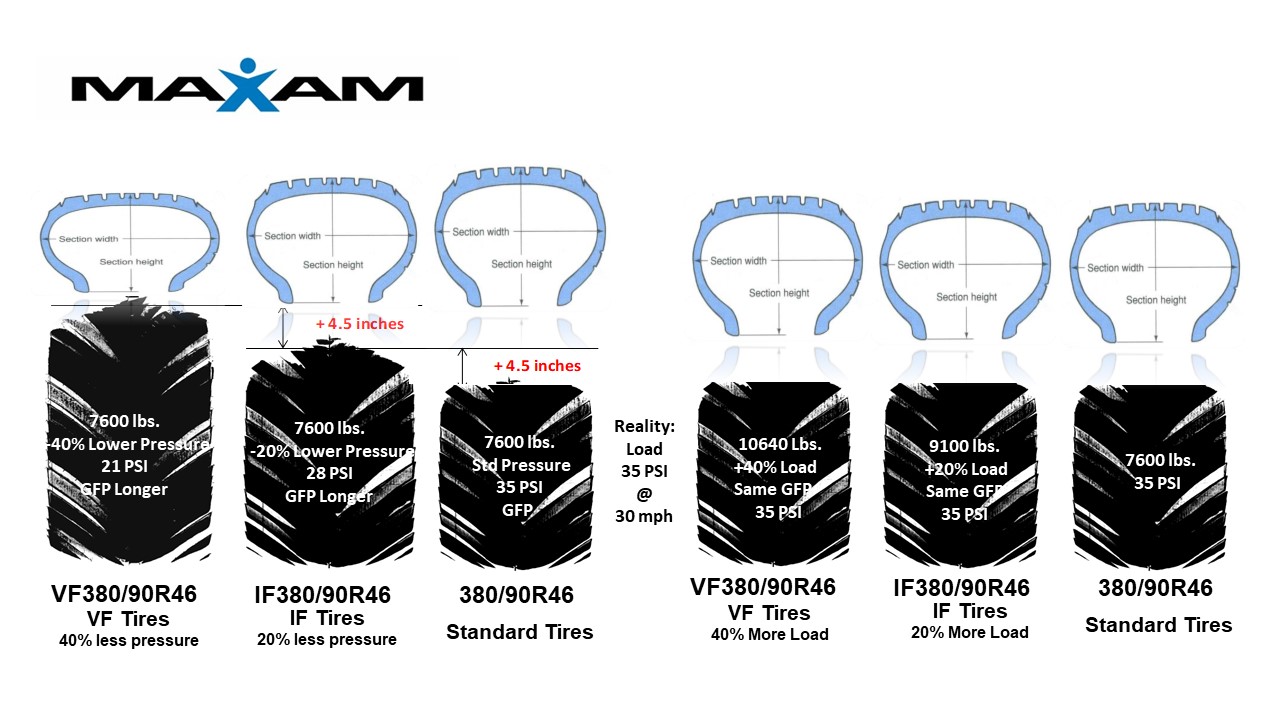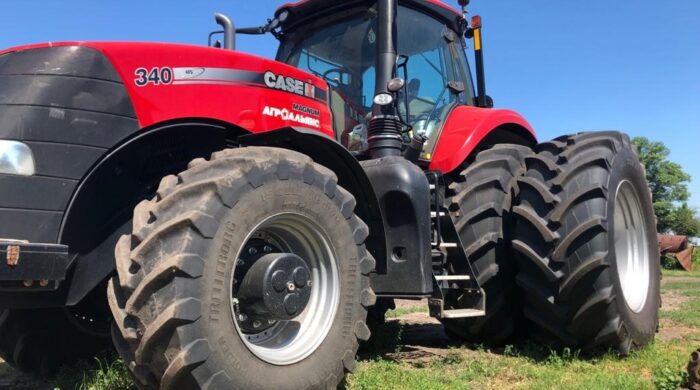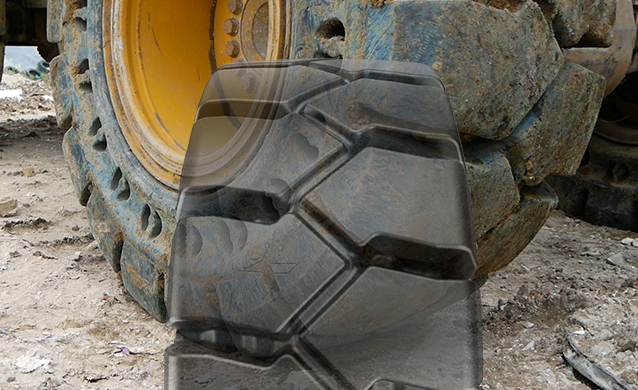MAXAM on Tire Single-Digit PSIs
AG Technical Bulletin – Why are producers hesitant to run AG Tires at recommended single-digit PSIs, what is required to do so, what precautions must be taken, and how are traction and flotation improved?
Agricultural tires in comparison to construction, commercial truck, and passenger or light truck tires operate at the lowest air pressure possible. The primary reason agricultural tires can operate at such low pressures is the combination of the size of the air chamber in an ag tire and the number of tires mounted on a vehicle allowing lower air pressures to be able to carry the weight. The secondary reason that ag tires need to operate at the lowest air pressure possible is to reduce the effect of the machine weight on the soil. By decreasing the ground pressure and soil compaction. Agricultural tires operating at the best possible pressure have a direct impact on crop production and can improve farmers’ and growers’ yields.
On average agricultural tires tend to operate between 12-20 psi on tractors working in the field. The advent of IF (Increased Flexion) and VF (Very Increased Flexion) technology is allowing tire air pressures to achieve much lower pressure down to 9 psi. The structural capability of tires impacts how much air pressure is required to carry the intended axle load:
- Radial tire casing construction carries 20% of the axle load while the pressurized air in the chamber carries the remaining 80%.
- Bias tire casing construction carries 40% of the axle load while the pressurized air in the chamber carries the remaining 60%
As technology continues to evolve with radial tires, especially with VF tires the ability to operate continuously at a working air pressure of 9 psi has become a commercial reality. Below are visual examples of the effect of air pressure, tire casing flexion, and tire footprint (gross flat plate) on standard, IF, or VF tires:

- Tire construction is sturdier and designed to be very flexible without compromising casing endurance or tire life.
- Greater load carrying or axle load capacity, if necessary, by adjusting the air pressure as needed
- When operated at -40% air inflation pressures, VF tires will reduce soil compaction improving crop yields due to the larger tire footprint and increased flotation over the soil resulting in lower ground pressure.
- VF Tires are designed to operate safely with a higher heat resistance of the casing despite -40% lower air pressure on the road or in the field.
- VF Tires have a long footprint when operating at -40% air inflation increasing tire contact patch or flotation, traction, and reducing tire slip.
- Lower air pressures also improve ride and have a greater contact patch (flotation) improving overall machine stability on the road or in the field.
- VF tire pressures when operating at -40% air inflation in fact enhance both traction and stability when on sloped or steep fields.
With all the above technological reasons that should convince or drive producers to convert to IF or VF Tires, below are the primary reasons producers hesitate to operate at these pressures:
- The perception is that the tires operating at low pressure (9 psi) are too low or look flat.
- Concern when having to transport (road) the machinery that lower air pressures will slow the equipment or consume more fuel.
- The perception is that low air pressure could lead to a tire flat in a remote area.
- Historically perceived comfort for operating at 16-18 psi as the lowest threshold of air inflation in the field.
- Concern that they must continuously adjust air pressures up or down which is time-consuming when changing equipment based on expected axle loads (heavier or lighter).
- Producers are comfortable with operating at one set inflation pressure that addresses all their equipment or load variables.
In the European market, tractors not only do the work in the field but are also used to transport crops or equipment over highways and roads at higher speeds than in other markets. This growing global need or market demand to operating at higher road speeds than in the field has necessitated equipment solutions to meet this requirement and overcome the above perceptions allowing the adoption of modern technologies such as IF or VF tire construction to improve operational results:
- Weighing the tractor or vehicle to set the fieldwork air pressure based on the highest weight implement and define an alternative higher air pressure for the same load when roading or transporting the tractor or vehicle = time tried mechanical but slow solution delivering a reliable practice that is time-consuming.
- Use of air pressure monitoring systems in the tractor or vehicle controls allowing for the stoppage of the equipment and manual adjustment to higher air pressures for the roading or transport part of the workday based on known or weighed axle loads= effective and accurate system providing the current state of tires and allowing for the adjustment of air inflation pressures but still very time-consuming.
- Adopting CTIS or centrally operated tire inflation systems, a purposely built onboard air pressure adjustment system that is connected to the tires and operated from the tractor or vehicle cab. The CTIS-type systems allow for immediate adjustment up or down of the tire inflation to accommodate for the fieldwork or transport (roading) air pressure requirements. Producers can instantly adjust the air to either accommodate for tire footprint needs lower air for a longer footprint for reduced soil compaction or increased air pressure for higher transport speeds = the most effective and time-reducing solution if at a higher initial acquisition price on a new or retrofitted vehicle
MAXAM VF tires are designed for either heavy load and high pressures (+40% Load) or lower air pressures for a given load (-40% air pressure); when used at higher pressures the tire casing will not be subjected to excessive flexing which ensures more durable or longer casing life. Producers need to adopt tire solutions that meet their operational and value needs. Each operation, crop, or soil condition will determine the type or size of equipment to be utilized. In each instance, producers have an opportunity to define and choose what technology or solutions best suit their operational requirements to achieve their operational objectives.
MAXAM’s continuing objective for 2022, and for the years to come is to deliver superior radial products in the right sizes, with the right load capabilities, that when operated at the right air pressure will deliver the value and fuel savings our customers expect from our tires. Backed by a world-class warranty program, MAXAM’s radial tires are manufactured to maximize performance, reduce compaction, and improve traction with superior stability resulting in increased productivity. Try the MAXAM advantage in your operations today!



